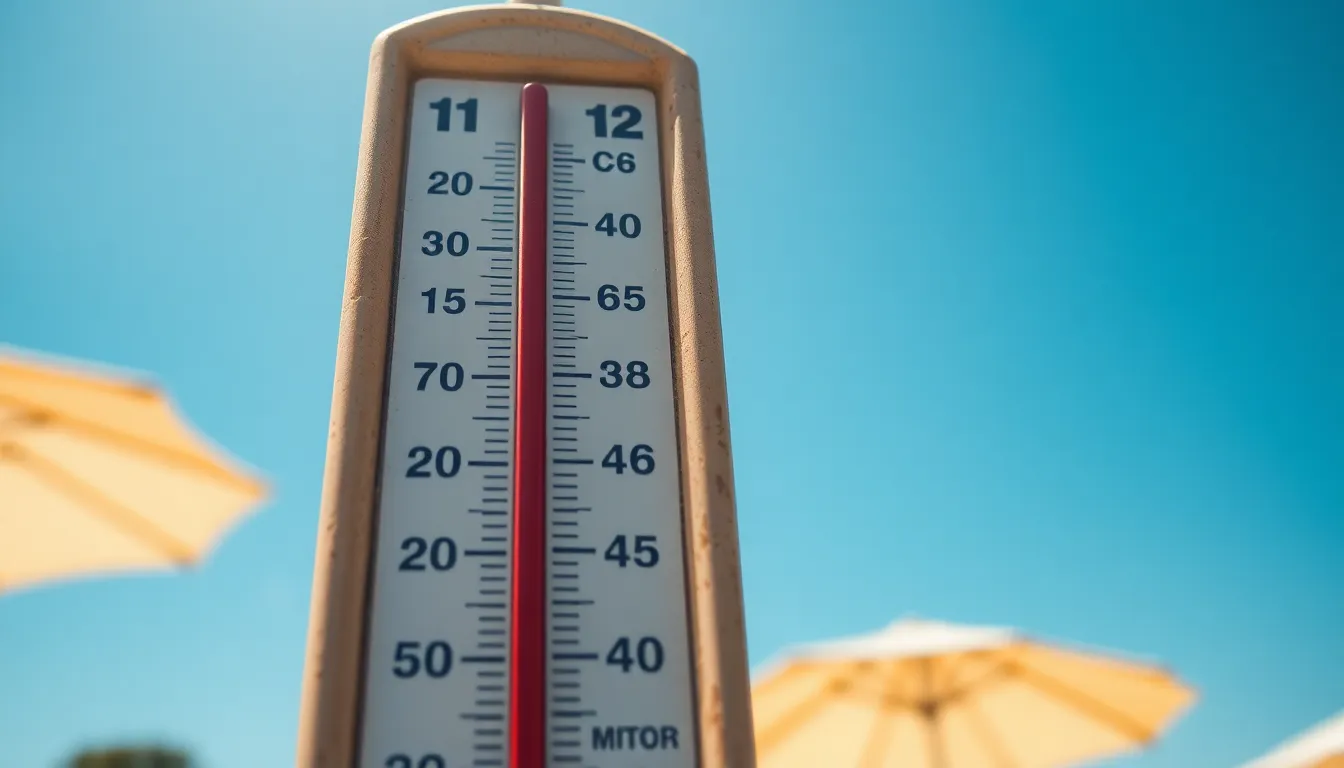When the temperature hits 44 degrees Celsius, it feels like stepping into an oven set to “broil.” But how does that translate into Fahrenheit? If you’ve ever found yourself sweating in the heat and wondering if you’re about to turn into a human rotisserie, you’re not alone. The conversion from Celsius to Fahrenheit can be a bit tricky, but fear not—this article’s got your back.
Table of Contents
ToggleUnderstanding Temperature Conversion
Temperature conversion involves changing a temperature reading from one scale to another. This section explores the Celsius and Fahrenheit scales to ease the conversion process.
The Celsius Scale
The Celsius scale bases temperature on the freezing and boiling points of water. Zero degrees Celsius represents the freezing point, while 100 degrees Celsius signifies the boiling point. Many regions worldwide use this scale, making it prominent in scientific contexts. Celsius is particularly useful in weather reporting, where temperatures often exceed typical values, such as 44 degrees. Understanding this scale ensures accurate interpretations of local climate conditions.
The Fahrenheit Scale
The Fahrenheit scale measures temperature with a different approach. Freezing occurs at 32 degrees Fahrenheit, while boiling happens at 212 degrees Fahrenheit. Primarily, the United States relies on this scale. Knowing the equivalent temperatures in Fahrenheit aids in practical applications, from cooking to weather forecasts. Familiarity with this scale helps individuals comprehend temperature reports when traveling or communicating with others across different regions.
How to Convert 44 Degrees Celsius to Fahrenheit

Converting 44 degrees Celsius to Fahrenheit involves a straightforward formula. Understanding this conversion helps in practical applications, such as cooking and weather forecasting.
The Conversion Formula
The formula for converting Celsius to Fahrenheit is:
[ F = left( C times frac{9}{5} right) + 32 ]
In this formula, F represents degrees Fahrenheit and C represents degrees Celsius. With this equation, calculating various Celsius temperatures becomes easy.
Step-by-Step Calculation
To find the Fahrenheit equivalent of 44 degrees Celsius, follow these steps:
- Multiply 44 by 9. This equals 396.
- Divide 396 by 5, resulting in 79.2.
- Add 32 to 79.2, which gives 111.2.
44 degrees Celsius converts to 111.2 degrees Fahrenheit.
Real-World Applications
Understanding the implications of 44 degrees Celsius, or 111.2 degrees Fahrenheit, proves essential in various settings.
Weather Reports
Weather reports frequently communicate temperature in Celsius worldwide, while Fahrenheit remains common in the U.S. Meteorologists use these scales for accurate temperature representation. They often convert temperatures for clearer public comprehension. Knowing how to convert helps people understand their local forecasts better and make decisions about outdoor activities. For instance, when planning outings during extreme heat, converting temperatures accurately informs choices about safety and hydration. When 44 degrees Celsius appears in a weather report, recognizing its Fahrenheit equivalent provides critical context for those in hotter environments.
Cooking and Baking
Cooking and baking require precise temperatures for optimal results, making the conversion essential. Recipes often include temperature settings in Fahrenheit, especially in the U.S., while many culinary sources use Celsius. Understanding how to convert allows chefs and home cooks to achieve consistency in their dishes. For example, a recipe that states cooking at 44 degrees Celsius translates to about 111.2 degrees Fahrenheit. This knowledge enables them to adjust cooking times effectively and prevent undercooking or overcooking. Accurate temperature conversion ensures that meals are prepared safely and tastefully.
Common Misconceptions
Misunderstandings about temperature scales frequently arise. Many people confuse Celsius with Fahrenheit, mistaking them for interchangeable measurements. Celsius reflects the scientific approach, focusing on freezing and boiling points of water at 0 and 100 degrees respectively. Fahrenheit, favored mainly in the U.S., starts at 32 degrees for water’s freezing point and reaches 212 degrees at boiling. Recognizing this difference helps clarify temperature discussions in different contexts.
Errors in conversion commonly occur. Miscalculations from incorrect formulas or misunderstanding the conversion process can lead to significant misinterpretations. A typical mistake involves reversing the order of operations or prematurely rounding results. For example, when converting 44 degrees Celsius to Fahrenheit, applying the formula F = (C × 9/5) + 32 incorrectly can result in inaccurate conclusions. Such oversights emphasize the importance of careful calculations in practical scenarios, including cooking and weather assessments.
Understanding the conversion from 44 degrees Celsius to Fahrenheit is crucial for navigating extreme temperatures. With 44 degrees Celsius equating to 111.2 degrees Fahrenheit, this knowledge helps individuals make informed decisions whether they’re planning outdoor activities or preparing meals.
Being aware of the differences between the Celsius and Fahrenheit scales can prevent confusion and ensure accurate temperature readings. This understanding is especially important in cooking and weather forecasting where precision matters. By mastering these conversions, anyone can enhance their ability to interpret temperatures effectively and safely.





